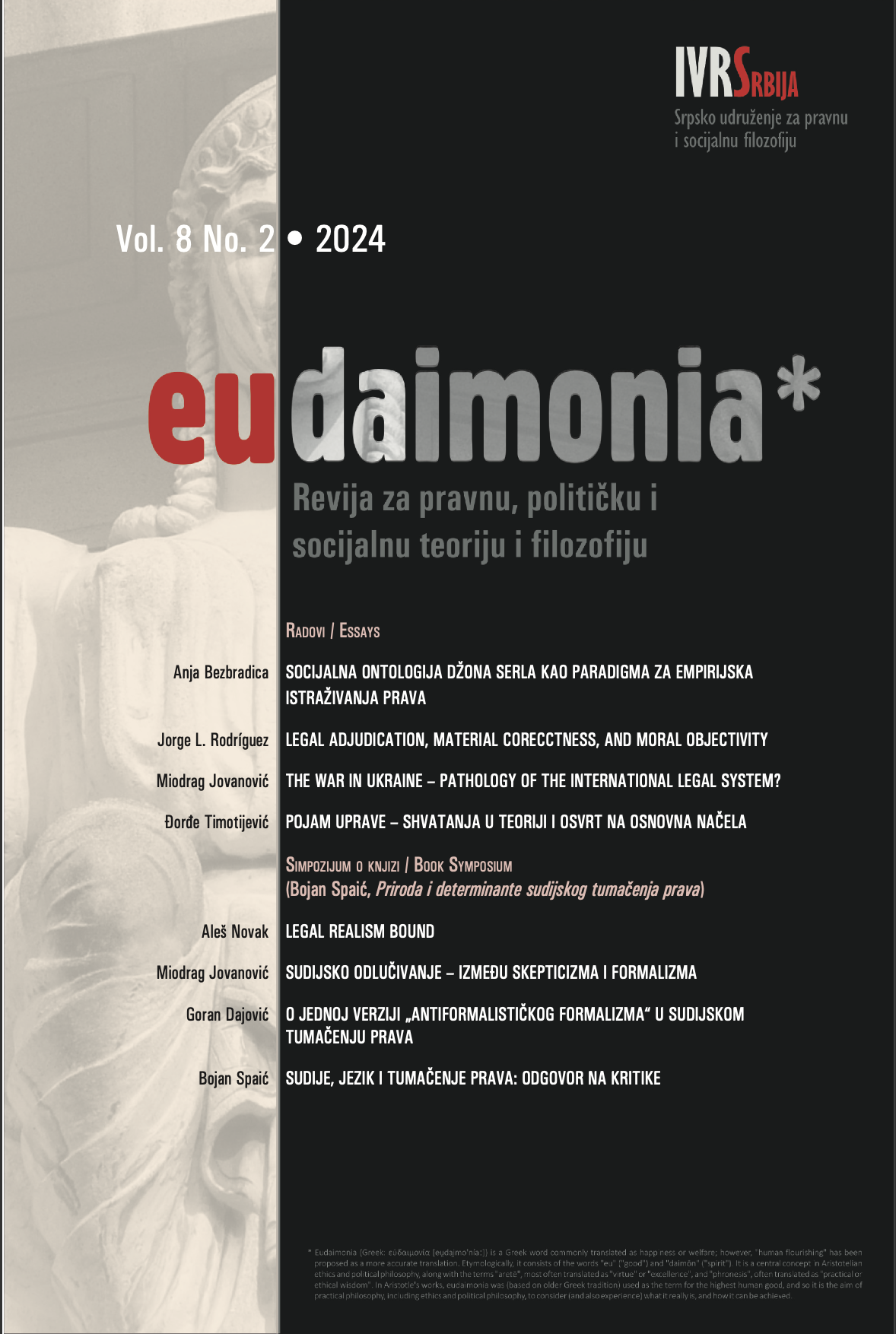JOHN SEARL’S SOCIAL ONTOLOGY AS A PARADIGM FOR EMPIRICAL RESEARCH OF LAW
DOI:
https://doi.org/10.51204/IVRS_24201AKeywords:
institutional facts, sociology of law, John Searle, collective recognition, social normAbstract
Neo-institutionalists like Neil McCormick and Ota Weinberger brought a significant shift to jurisprudence by viewing law as a specific social fact – the institutional one. This perspective moved away from the voluntarism of traditional legal science, pointing instead on social practices as a locus of law’s normativity. While this approach emphasized the factual aspects of law, neo-institutionalism primarily maintained an analytical and normative stance. Our analysis aims to highlight its potential for exploring alternative paths, such as engaging in sociological and other empirical research of law. We believe that John Searle’s social ontology, from which neo-institutionalists borrowed the concept of institution, provides substantial motivation for such direction. In this paper, we tried to detect those aspects of Searle’s theory of institutions from which themes/hypotheses for sociological and other scientific research of law can be derived, as well as to point out the possible directions of their development.
References
Althusser, Louis. 2001. Lenin and Philosophy and Other Essays. New York: Monthly Review Press.
Bezbradica, Anja. 2–3/2023. Bureaucratic Legal Consciousness: Perception of the Right to Access to Information of Public Importance in Public Authorities in Serbia. Zbornik Instituta za kriminološka i sociološka istraživanja 42: 1–24.
Blankenburg, Erhard, Freek Bruinsma. 1994. Dutch Legal Culture. Deventer and Boston: Kluwer Law and Taxation Publishers.
Burazin, Luka. 2022. Legal Systems as Abstract Institutional Artifacts, in Law as an Artifact (Ed. Luka Burazin, Kenneth Einar Himma, Corrado Roversi). Oxford University Press.
Campbell, Colin, Wesley Carson, Paul Wiles. 1973. Knowledge and Opinion about Law. London: Martin Robertson and Company Ltd.
Cowan, Dave. 2004. Legal Consciousness: Some Observations. Modern Law Review, Vol. 67, No. 6: 928–958.
Durkheim, Emile. 2013. The Division of Labour in Society. Bloomsbury Publishing. https://www.perlego.com/book/2996454/durkheim-the-division-of-labour-in-society-pdf, poslednji pristup 24. februara 2024.
Ehrlich, Eugen. 1986. Gesetz und lebendes recht: vermischte kleinere schriften. Berlin: Duncker und Humblot.
Ewick, Patricia, Susan S. Silbey. 2014. The Common Place of Law. The University of Chicago Press. https://www.perlego.com/book/1874576/the-common-place-of-law-pdf, poslednji pristup 1. marta 2024.
Fridman, Lorens M. 2014. Pravni sistem. Podgorica: CID.
Giddens, Anthony. 2013. The Constitution of Society. Polity Press. https://www.perlego. com/book/1535565/the-constitution-of-society-outline-of-the-theory-of-structuration-pdf, poslednji pristup 7. marta 2024.
Gramsci, Antonio. 2011. Prison Notebooks. Columbia University Press.
Hertogh, Marc. 2018. Nobody’s Law. Palgrave Macmillan UK. https://www.perlego.com/book/3493117/nobodys-law-legal-consciousness-and-legal-alienation-in-everyday-life-pdf, poslednji pristup 7. marta 2024.
Litowitz, Douglas. 2/2000. Gramsci, Hegemony, and the Law. BYU Law Rev 2000: 515–551.
Luhmann, Niklas. 2014. A Sociological Theory of Law. New York: Routledge.
MacCormick, Neil, Ota Weinberger. 1986. An Institutional Theory of Law: New Approaches to Legal Positivism. Dordrecht, Holland-Boston: D. Reidel Publishing Co.
MacCormick, Neil. 2014. Institucije prava. Zagreb: Naklada breza.
Menger, Karl. 6/1892. On the Origin of Money. The Economic Journal 2: 239–255.
Pintore, Anna. 1998. Institutionalism in Law, in Routledge Encyclopedia of Philosophy (Ed. Edward Craig). London, New York: Routledge.
Searle, John. 1969. Speech Acts. Cambridge: Cambridge University Press.
Searle, John. 1983. Intentionality. Cambridge: Cambridge University Press.
Searle, John. 1984. Minds, Brains, and Science. Cambridge Massachusetts: Harvard University Press.
Searle, John. 1992. The Rediscovery of the Mind. Cambridge Massachusetts: The MIT Press.
Searle, John. 2010a. The Construction of Social Reality. New York: Free Press. https:// www.perlego.com/book/779804/the-construction-of-social-reality-pdf, poslednji pristup 7. marta 2024.
Searle, John. 2010b. Making the Social World: The Structure of Human Civilization. Oxford University Press.
Tamanaha, Brian Z. 2017. A Realistic Theory of Law. Cambridge University Press.
Treviño, Javier. 2017. The Sociology of Law. Taylor and Francis. https://www.perlego.com/book/1578781/the-sociology-of-law-classical-and-contemporary-perspectives-pdf, posled- nji pristup 24. februara 2024.
Tyler, Tom. 1/2009. Legitimacy and Criminal Justice: The Benefits of Self-Regulation. Ohio State Journal of Criminal Law 7: 307–360.
Tyler, Tom. 2021. Why People Obey the Law. Princeton University Press. https://www.perlego.com/book/2377736/why-people-obey-the-law-pdf, poslednji pristup 7. marta 2024.
Werner, Wouter. 23/1995. Legal signs and legal science: The relevance of pragmatism for the institutional theory of law. International journal for the semiotics of law 8: 207–2018.
Kelzen, Hans. 2010. Opšta teorija države i prava. Beograd: Pravni fakultet Univerziteta u Beogradu.
Hart, Herbert. 2013. Pojam prava. Beograd: Pravni fakultet Univerziteta u Beogradu.

Downloads
Published
Versions
- 07.02.2025 (2)
- 13.09.2024 (1)

